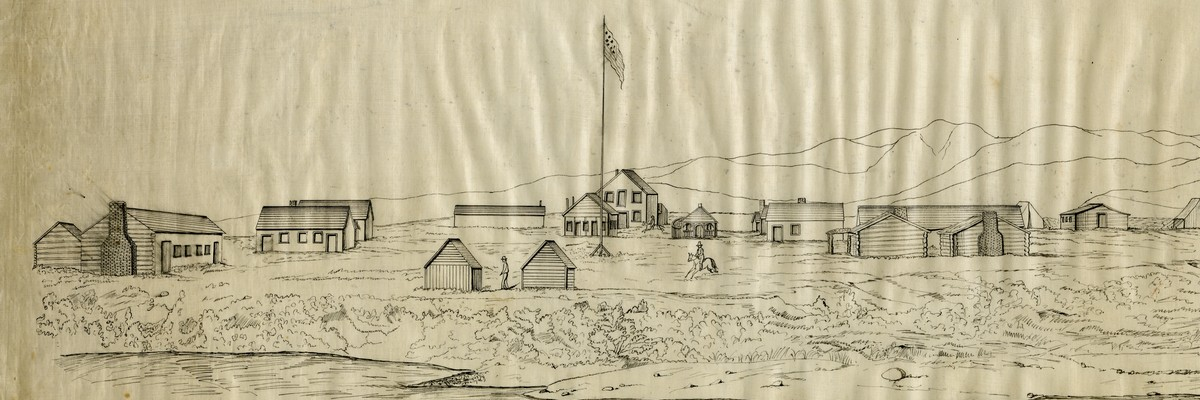
Above is a drawing of the Fort Collins military post in 1865 by David Van Lennep.
[The town of] Fort Collins had its beginning on July 22, 1862, when soldiers were sent from the 9th Kansas Cavalry at Fort Laramie to what is now the town of Laporte to protect the Cherokee trail and to guard the Overland Stage Line.
The name "Camp Collins" was given to the post by Gen. James Craig in honor of Lt. Col. William O. Collins, the able and popular commander of Ohio Cavalry troops whose headquarters were at Fort Laramie.
After three and a half months, the Kansas Cavalry was replaced by Colorado troops who manned Camp Collins until May, 1864, when Company F of the 11th Ohio Cavalry was ordered by Col. Collins to relieve the Colorado soldiers.
A devastating flood rushed down the canyon of the Cache la Poudre River during the night of June 9, 1864. Flooding Camp Collins, it carried tents, ammunition and some of the cabins downstream. The soldiers managed to retreat to the nearest bluff without lives being lost, but the morning presented a scene of desolation: a sea of muddy water and only the roofs of a few cabins visible.
Soon a search began for a new location for the post. Joseph Mason (credited with being Fort Collins' first white settler) was living on his farm between the present North Shields and Wood Street on Vine Drive. Mason pointed out land on the Cache la Poudre River in the vicinity of the present Willow Street.
On August 20, 1864, Col. Collins signed the order setting aside the present location of Fort Collins as the new military reservation. Here the danger of flooding would be less and sufficient land was available without interfering with the claims of individuals. Thus it is August 20 that Fort Collins Historical Society honors as the celebration of Fort Collins' birthday.
In October of 1864 the new post was ready for occupation and the term "Fort Collins" is used instead of "Camp Collins" in the order book, although there seems to have been no official order for the change.
For almost two years Fort Collins remained a military post until the last soldiers were evacuated in September, 1866. The only building from the old fort that has been preserved is the Auntie Elizabeth Stone cabin which has been moved to Library Park. Originally located on Jefferson Street just back of the present Major Motor Supply [Note: Downtown Artery now occupies the old Major Motor Supply building], the cabin was built as an officers' mess hall, with Auntie Stone in charge. She was the first white woman to be a permanent resident of Fort Collins.
A few farms and ranches were located around Fort Collins and squatters settled on the abandoned military reservation in "Old Town" along the river before legal snarls were untangled to open government land to settlement. Finally on May 15, 1872, Congress opened the reservation to pre-emption homesteading and that same year the Agricultural Colony arrived to buy land and plat out Fort Collins. Old Town had been built parallel to the river, while New Town was attached to it, being square with the compass. Fort Collins was incorporated as a town February 3, 1873. Statistics of 1870 give the entire population of Larimer County as 838 people. (At that time the present Jackson County was included in Larimer County.)
Fort Collins' first business was the former sutler's store, Old Grout, at the southwest corner of Linden and Jefferson Streets. Old Grout was so named because of the grouting material of which it was constructed. Razed in 1882, it had served as an all-purpose building for holding meetings, church services, dances, court sessions and incarcerating prisoners, as well as housing the general store.
Realizing that irrigation was necessary for crops in this arid area, settlers near the present Bellvue dug the first irrigation ditch in 1860 to take water from the Cache la Poudre River. From that time on there began to develop Larimer County's elaborate system of irrigation and water supply that we know today as the lifeblood of a rich agricultural region.
It was with rejoicing that the first railroad was welcomed to Fort Collins as it chugged down Mason Street (its present location) on the morning of October 8, 1877. Livestock and farm products could now be shipped out and consumer goods brought in at a reasonable cost and with savings in time. Travelers, too, found it a convenience, especially before automobiles began appearing shortly after the turn of the century. Another milepost in Fort Collins' progress was the opening of Colorado Agricultural College (now CSU) in the fall of 1879. Ten years later the first high school opened on the second floor of Franklin School, which once stood where Steele's Market on West Mountain is now located. [Note: Steele's Market closed in 2001. The lot is on the southwest corner of Mountain and Howes, near present day Key Bank.]
From its beginnings to the present "Choice City" of some 70,000 inhabitants [Note: 2016 population is over 150,000], Fort Collins owes its growth to many factors: mild, dry climate; proximity to mountains, rivers and lakes; location of important industry; favorable conditions for agriculture and livestock; and Colorado State University with 17,000 students [Note: 2016 student enrollment is 33,000] as the city's chief employer.
Editor's note: This text has been updated with current demographics and developments. Edited January 3, 2017.


Preserving the history of Fort Collins, Colorado & the Cache la Poudre region